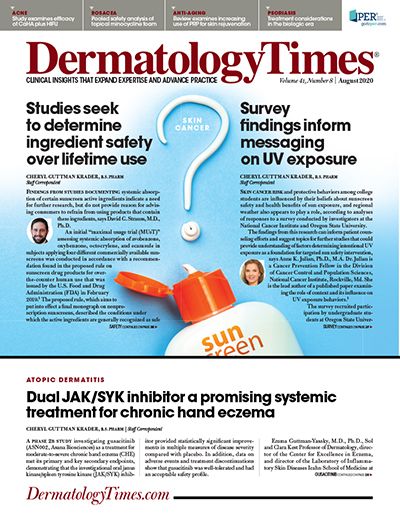- Acne
- Actinic Keratosis
- Aesthetics
- Alopecia
- Atopic Dermatitis
- Buy-and-Bill
- COVID-19
- Case-Based Roundtable
- Chronic Hand Eczema
- Drug Watch
- Eczema
- General Dermatology
- Hidradenitis Suppurativa
- Melasma
- NP and PA
- Pediatric Dermatology
- Pigmentary Disorders
- Practice Management
- Precision Medicine and Biologics
- Prurigo Nodularis
- Psoriasis
- Psoriatic Arthritis
- Rare Disease
- Rosacea
- Skin Cancer
- Vitiligo
- Wound Care
Publication
Article
Dermatology Times
Nanotechnology: An opportunity to advance skin cancer treatment
Author(s):
In cancer immunotherapy, nanoparticles can be directed to different cells and tissues related to the immune response. This technology is currently being investigated to enhance drug delivery in skin cancer therapy with the hope of promoting more robust antitumor effects and improved clinical outcomes.
Novel and emerging nanotechnology approaches used in the treatment of skin cancer are generating interest as they enable the efficient delivery of drugs and other bioactive molecules to target tissues with low toxic effects. A recent study1 examined current investigations of nanoparticle and nanosystems and highlighted the therapeutic benefit and potentially larger role in the treatment of skin cancer.
Depending on disease stage, melanoma and nonmelanoma skin cancers can be treated in a variety of ways. However, the limitations of some treatment modalities have led research to explore new delivery systems and approaches to help improve clinical outcomes.
“The molecular mechanisms of melanoma have not been entirely elucidated; therefore, treating the disease is difficult. To overcome this challenge, innovative therapies are required that are mainly based on delivery systems using nanotechnology,” writes Livia Neves Borgheti-Cardoso, Ph.D., School of Pharmaceutical Sciences of Ribeirao Preto, University of Sao Paolo, Ribeirao Preto, San Paolo, Brazil, and fellow colleagues, in a study published in Advanced Drug Delivery Reviews.
One of the many recent advancements in the treatment of cancer has been nanotechnology and the nanosystems that they employ. Nanoparticles efficiently deliver therapeutic agents to the tumor site which can include chemotherapeutics, immune and vaccine molecules, and nucleic acids.
“Nanosystems can be developed to overcome biological barriers and to target drug delivery to the tumor sites, thus enabling the use of lower doses, increasing treatment efficacy and decreasing the number and/or the severity of the side effects,” the study authors write.
Most nanotechnology approaches and systems are still in the research and development phase; however, some have reached the clinical stage and are currently available on the market. There are no commercially available nanosystems to date for bioactive molecule topical delivery for skin cancer, the study authors write that some nanoparticle applications and products are being evaluated in clinical trials for advanced solid tumors as well as nonmelanoma skin cancers. The latter is a dose-rising study2 currently underway evaluating a topical nanoparticle paclitaxel ointment for safety, tolerability, and the preliminary efficacy of three concentrations (0.15 percent, 1.0 percent, and 2.0 percent) of the nanoparticle for the treatment of cutaneous metastases from nonmelanoma skin cancer.
Nanoparticles are currently being investigated to enhance the drug delivery of different agents in skin cancer therapies such as chemotherapy, immunotherapy including the PD-1 inhibitors, as well as therapeutic vaccines, with the hope of promoting more robust antitumor effects and improved clinical outcomes.
In cancer immunotherapy, nanoparticles can be directed to different cells and tissues related to the immune response including antigen presenting cells, lymphocytes and lymphoid tissues, thereby overcoming the limitations of direct cancer cell targeting. According to the study authors, one important advantage of using nanoparticles for antigen delivery is their capability to carry several adjuvants or neoantigens, which is ideal for treating different cancers.
When used in combination with physical techniques, nanocarriers could also help enhance topical and transdermal drug delivery in the treatment of melanoma and nonmelanoma skin cancers. Physical enhancement methods used include laser irradiation (i.e., phototherapy, thermotherapy, and acoustic therapy), iontophoresis, ultrasound, and microneedling systems.
A promising alternative for overcoming multidrug resistance, the authors explained that nanotechnology can also help the clinician provide treatment in a specific and orderly fashion, with smaller doses of therapeutic agents and fewer toxic effects.
“The use of nanocarriers enables the effective, targeted delivery of several therapeutic agents made from combinations of molecules aimed at acting synergistically and effectively against cancer types that are resistant and no longer responsive to conventional therapies,” the authors write.
Nanoparticles also used together with high-cost therapies including immunotherapies and gene therapies enable a more efficient administration of treatment, which can result in a more cost-effective approach and improved clinical outcomes.
“The versatility of these nanocarriers grows exponentially because although their use adds to the cost of therapy, it comes with innumerable benefits, which in terms of cost-effectiveness, are worth conceding, as these benefits lead to greater prospects for diagnosis and treatments, in addition to allowing the use of theranostics in cancer patients,” the study authors say.
Disclosures:
The authors report no relevant disclosures.
References
1 Borgheti-Cardoso LN, Viegas JSR, Silvestrini AVP, et al. Nanotechnology approaches in the current therapy of skin cancer. [Epub ahead of print February 27, 2020] Adv Drug Deliv Rev, doi: 10.1016/j.addr.2020.02.005.
2 NanOlogy, LLC. Study of topical S)R007 ointment for cutaneous metastases. Available from: https://clinicaltrials.gov/ct2/show/NCT03101358. NLM identifier: NCT03101358. Accessed June 2020.































